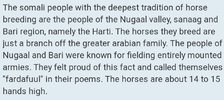Hamzza
VIP
Faras (= horse). Somalis are very fond of horses for their extraordinary beauty, for their usefulness in fighting and raiding other people's camels, or because they are considered as the best gift that can be given to someone (together with camels and guns) especially as a wedding gift. . Somali folk (oral) literature and tradition are full of poems and tales about horses. Numerous horses have become famous with almost mythical names like these (in brackets the relative owners, all prominent characters in the Somali tradition):

Aflahaare (Gooni)
Dhaayatiix (Cali Duullane)
Dhooddi (Sayid Maxamed ')
Kufri-diid (Maxaamuud Sugulle)
Lafcir (Cali Tumaaleed)
Meydal Qale (Cali Yuusuf 'Ardaa-Baasle')
Nasis (Dafar & Ciise Jibriil Cadde)
Oog (Kooshin Cigaal Galangal)
Qadow Taliye (Boos-Iley)
Quruxboob (Cali Sharmaarke)
Roor Godan (Aadan Gallayr)
Siigacir (Cartan Boos)
Soofe (Afxakame)
Tuke (Dhoorre Xasan)
Tuke (Nuur Tallaabo)
Urur (Cali Keenadiid)
Wacdar (Warfaa Maxamuud: Warfaa-Waranweyne)
Weyrax (Wiil Waal)
Xamar-cartan (boqor cismaan)
Xamar-Cillaan (Afcad)
Xiin Finiin (Sayid Maxamed & Reer Islaan)

Sayid Maxamed's poems about horses are the best. Outstanding among these are those titled "Xiin Finiin ,' Dhooddi', 'Calanside', 'Fookheeye' and 'Walhad' stand out. Here is a poem and a short story about horses, both of which are very popular. The poem, a 'gabay' in 'alif', is by a poet Ogaadeen 'and is addressed to Dhoorre (also called Cigaal) Xasan Samatar Khalaf, father of the famous Abshir Dhoorre, one of Sayid Maxamed's lieutenants. In it the poet Ogaadeen asks Tuke, Dhoorre's favorite horse, for an 'afarmidable' , that is a 'four-color', and discards all other types of horses. An afarmidable ', the connoisseurs say, is born first black; then it becomes white with black spots on the back, that is, it becomes a 'baroor-madow' (gray-black); then patches and small red spots called 'caar' appear on the coat; and finally becomes very white or 'baroor-cad' (gray-white). The poet opens the poem with the name of Axmed Nuur Islaan, who had relations both with the Reer Islaan, his relatives, and with the Ogaadeen, his maternal uncles. The title of the 'gabay' is 'Yuusan li Imannin' (= don't send it to me). The tale, on the other hand, is a very common legend among Somalis, and, like the poem, it divides horses according to their coat or color. According to the story, each subdivision would have certain characteristics in common and therefore a behavior known to horse experts. The tale as well as the poem are unfortunately incomplete and many types of horses are not mentioned.
a) 'Yuusan li Imannin'.
1. Axmed Nuur Islaanow adaa ayda sii mariye
2. Adigaa sibraarkuu asladay oogadii Muduge
3. Isha'allaahu maantaad tagtaan oodda Reer Cigalle
4. Arbayaasha Reer Samatar Khalaf amarrawaaweynta
5. Dadku kala ikhyaarsane Cigaal maalintaad aragtid
6. Amase waa asmee iiga gee idilba Reer Dhoorre
7. Nin ugaarsadaa Xamarka jecel eri danbeedkiise
8. Usha iyo dhawaaquu sugaa, yuusan ii imannin;
9. Ashkir orodki waa maalintuu oofo weyn yahaye
10. Nin ol'olaha badiyaan ahee, yuusan ii imannin;
11. Bullaale af-adayggaan ku nacay aar ha soo rido e
12. Niman urursan buu kuu geshaa, yuusan ii imannin;
13. Ma irdhaysna oo caynab waa faras Ogaadeene
14. Oday baa ubbada loo suraa, yuusan ii imannin;
15. Hadduu oomo boosaga naftay kala aguugaane
Aflahaare (Gooni)
Dhaayatiix (Cali Duullane)
Dhooddi (Sayid Maxamed ')
Kufri-diid (Maxaamuud Sugulle)
Lafcir (Cali Tumaaleed)
Meydal Qale (Cali Yuusuf 'Ardaa-Baasle')
Nasis (Dafar & Ciise Jibriil Cadde)
Oog (Kooshin Cigaal Galangal)
Qadow Taliye (Boos-Iley)
Quruxboob (Cali Sharmaarke)
Roor Godan (Aadan Gallayr)
Siigacir (Cartan Boos)
Soofe (Afxakame)
Tuke (Dhoorre Xasan)
Tuke (Nuur Tallaabo)
Urur (Cali Keenadiid)
Wacdar (Warfaa Maxamuud: Warfaa-Waranweyne)
Weyrax (Wiil Waal)
Xamar-cartan (boqor cismaan)
Xamar-Cillaan (Afcad)
Xiin Finiin (Sayid Maxamed & Reer Islaan)
Sayid Maxamed's poems about horses are the best. Outstanding among these are those titled "Xiin Finiin ,' Dhooddi', 'Calanside', 'Fookheeye' and 'Walhad' stand out. Here is a poem and a short story about horses, both of which are very popular. The poem, a 'gabay' in 'alif', is by a poet Ogaadeen 'and is addressed to Dhoorre (also called Cigaal) Xasan Samatar Khalaf, father of the famous Abshir Dhoorre, one of Sayid Maxamed's lieutenants. In it the poet Ogaadeen asks Tuke, Dhoorre's favorite horse, for an 'afarmidable' , that is a 'four-color', and discards all other types of horses. An afarmidable ', the connoisseurs say, is born first black; then it becomes white with black spots on the back, that is, it becomes a 'baroor-madow' (gray-black); then patches and small red spots called 'caar' appear on the coat; and finally becomes very white or 'baroor-cad' (gray-white). The poet opens the poem with the name of Axmed Nuur Islaan, who had relations both with the Reer Islaan, his relatives, and with the Ogaadeen, his maternal uncles. The title of the 'gabay' is 'Yuusan li Imannin' (= don't send it to me). The tale, on the other hand, is a very common legend among Somalis, and, like the poem, it divides horses according to their coat or color. According to the story, each subdivision would have certain characteristics in common and therefore a behavior known to horse experts. The tale as well as the poem are unfortunately incomplete and many types of horses are not mentioned.
a) 'Yuusan li Imannin'.
1. Axmed Nuur Islaanow adaa ayda sii mariye
2. Adigaa sibraarkuu asladay oogadii Muduge
3. Isha'allaahu maantaad tagtaan oodda Reer Cigalle
4. Arbayaasha Reer Samatar Khalaf amarrawaaweynta
5. Dadku kala ikhyaarsane Cigaal maalintaad aragtid
6. Amase waa asmee iiga gee idilba Reer Dhoorre
7. Nin ugaarsadaa Xamarka jecel eri danbeedkiise
8. Usha iyo dhawaaquu sugaa, yuusan ii imannin;
9. Ashkir orodki waa maalintuu oofo weyn yahaye
10. Nin ol'olaha badiyaan ahee, yuusan ii imannin;
11. Bullaale af-adayggaan ku nacay aar ha soo rido e
12. Niman urursan buu kuu geshaa, yuusan ii imannin;
13. Ma irdhaysna oo caynab waa faras Ogaadeene
14. Oday baa ubbada loo suraa, yuusan ii imannin;
15. Hadduu oomo boosaga naftay kala aguugaane




